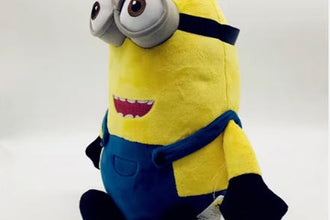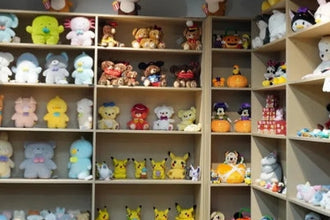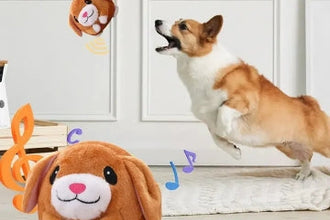Custom plush toys have transcended over time into far more than just children’s toys for play; today, they are often collectibles, product promotional items, and individual gifts. One of their chief challenges, however, is that there is a growing concern about durability, regardless of purpose. Consumers demand plush toys be sturdy as they are being dealt with, washed, and displayed under ordinary conditions without suffering from rapid loss of their shape, color or structural value. The construction of custom plush toys must take care to reduce the long age and the impact on them with respect to materials, construction methods and quality control measures if they are to be extended over time.

Why Improving the Durability of Custom Plush Toys is Essential
1. Enhancing Customer Satisfaction
Improving the durability of custom plush toys usually focuses on maximizing customer satisfaction. Even after dealing with these toys often, consumers expect them to never lose softness, preservation and aesthetics. A plush can be disappointed and have its name damaged when it loses shape, tears or starts developing color fading very quickly. On its head, durable toys make users happy for a long time, which leads to the enjoyment and repeat purchase, while their non-familiar companions don’t.
2. Reducing Returns and Complaints
Good strength is directly related to product quality. Toys that break prematurely often result not only in loss but also in returns, complaints, and any safety fears that can arise. By creating materials designed with reinforced stitching and high quality and the features that are always fastened securely together, corporations can bring down these problems. This not only saves costs incurred when bringing in returns to the company or the replacement of previously sold toys but also strengthens consumer trust in your company.
3. Increasing Longevity and Play Value
An increase in durability prolongs the life of the plush toy; it extends the life of the plush toy itself for years as children and collectors go on to enjoy the toys. Toys of high quality that retain shape, softness, and aesthetics endure to the stresses of play and handling with a lot of playfulness and playfulness maximize the value, functional, emotional, the aesthetic.
4. Maintaining Safety Standards
Durable construction also adds to safety. Poor seaming or loosely bonded joints or holes in the seams can be a choking hazard or dangerous if the product has many loose parts when attached to one another, especially for children. Proven products that are made and tested under stress will ensure the robustness of plush toys is ensured, and the custom plush manufacturers will be able to make sure to supply such products that are safe and reduce the chances if a fault occurs.
5. Supporting Brand Reputation and Market Competitiveness
When a plush toy is durable, it demonstrates good quality workmanship and attention to detail and, thus, adds to brand name. In a competitive marketplace, only durable products can stand out in the market and command premium prices. Brands that invest in strong-filling long-term durability embody high-quality performance, loyalty and market force.
6. Environmental Considerations
Finally, durable plush toys contribute to sustainability. Toys that last also make them require less replacement for longer, less material waste and lower the impact on the environment. Good durable toys are becoming increasingly important, matching consumer demands for sustainable, responsible toys.

Key Strategies for Improving the Durability of Custom Plush Toys
1. Choosing High-Quality Materials
The foundation of any durable custom plush toy lies in its materials.
This chart helps quickly visualize which materials contribute to durability, where they are best used, and their specific benefits.
|
Material Type |
Key Features |
Benefits for Durability |
Typical Applications |
|
Plush Fabrics (Minky, Velour, Fleece) |
Soft texture, dense weave, colorfast |
Resistant to pilling, tearing, and fading; maintains softness |
Standard plush toys, stuffed animals, decorative plush |
|
Polyester Fiberfill |
Lightweight, hypoallergenic, consistent density |
Retains shape under compression, washable, long-lasting |
Stuffing for all types of plush toys |
|
High-Grade Cotton or Cotton Blends |
Natural feel, breathable, strong fibers |
Durable for handling, gentle on skin, holds stitching well |
Eco-friendly or premium plush lines |
|
Embroidered Threads |
Polyester or rayon threads |
Resistant to fraying and detachment |
Facial features, logos, decorative details |
|
Plastic Safety Components (Eyes, Noses) |
Non-toxic, securely anchored |
Long-lasting, resistant to impact |
Eyes, noses, and small accessories |
|
Reinforcement Materials (Wire Frames, Stiffened Inserts) |
Flexible yet strong |
Maintains posture and structure |
Limbs, tails, or upright plush designs |

2. Reinforced Stitching and Seams
Even the finest materials can fail if the construction is weak. Reinforced stitching, especially in stress-prone areas such as limbs, ears, and tails, significantly increases durability.
This chart highlights the key stitching techniques and considerations that directly contribute to the structural integrity and longevity of custom plush toys.
|
Aspect |
Technique |
Benefits |
Application |
|
Seam Type |
Double or triple stitching |
Reduces risk of tearing, improves overall strength |
Recommended for all high-stress areas like limbs, tails, and ears |
|
Seam Alignment |
Careful matching of fabric edges |
Prevents uneven tension that can lead to ripping |
Critical for toys with complex shapes or multiple panels |
|
Stress Point Reinforcement |
Hidden reinforcement stitches or bar tacks |
Strengthens joints without affecting appearance |
Use on limbs, neck, joints, and areas subject to frequent handling |
|
Thread Selection |
High-strength polyester or nylon thread |
Resists fraying, snapping, and stretching |
Preferably color-matched for aesthetic consistency |
|
Seam Finish |
Overlocking or serging edges |
Prevents fabric fraying and prolongs life |
Essential for raw fabric edges before final stitching |
3. Durable Attachments and Embellishments
Custom plush toys are usually embroidered with elements, such as embroidered eyes, plastic parts, ribbon, fabric or cloth. Failure to adequately secure these embellishments can become weak points. Since it is peeling- and non-detached from an object, glue or loose sewn patch will not pull the pieces off easily, making embroidery a good choice. Plastic parts need to meet safety standards and be secure in place. To increase the durability, include removable or replaceable accessories to minimize the wear placed on the main plush body.

4. Thoughtful Design Considerations
Simple shapes with less protruding shape often last longer, particularly for a toddler’s toy. Sizing up seams, using just short stretch joints, and stress testing joints are keys to a toy’s structural longevity. Designers should also look ahead to washing and drying processes, to ensure that the features of the toy are resilient to repeated cleaning without deformation.
5. Quality Control and Testing
Even with high-quality materials and skilled craftsmanship, rigorous quality control for plush toys ensures consistency.
This chart provides a clear overview of the essential quality control and testing steps that ensure custom plush toys are durable and long-lasting.
|
Aspect |
Method |
Purpose |
Key Considerations |
|
Material Inspection |
Check fabrics, stuffing, threads, and attachments |
Ensure materials meet durability and safety standards |
Colorfastness, tensile strength, non-toxicity, hypoallergenic compliance |
|
Seam and Stitching Inspection |
Visual inspection, seam strength testing |
Detect weak or uneven stitching |
Stress-prone areas like limbs, ears, tails; double/triple stitching verification |
|
Stress Testing |
Compression, pulling, bending |
Simulate real-life handling and usage |
Repeated pressure and stretching to assess shape retention and seam strength |
|
Washing and Cleaning Tests |
Machine wash, hand wash, air drying |
Verify resistance to shrinkage, color fading, and deformation |
Include mild and standard detergent scenarios, multiple wash cycles |
|
Accessory and Attachment Checks |
Tug test for eyes, noses, and sewn-on elements |
Ensure embellishments remain securely attached |
Embroidery vs. glued components, safety compliance for children’s toys |
|
Batch Sampling |
Random sampling from production batches |
Maintain consistency across units |
Follow standardized sampling ratios and documentation |
|
Final Product Inspection |
Comprehensive visual and tactile check |
Confirm overall quality, look, and feel |
Check for defects, proper stuffing, shape, and finish |

6. Maintenance and Care Guidance
Durability is also supported by providing end-users with clear maintenance instructions. Recommending gentle machine or hand washing, air drying, and avoiding harsh detergents for custom plushies can extend the toy’s lifespan. Some manufacturers include removable covers or protective elements to make cleaning easier without compromising structural integrity.

Choosing the Right Manufacturer for Durable Custom Plush Toys
Selecting the right custom plush toy manufacturer means that all products are created with care and detail, from how materials were sourced through to where they are then assembled, all resulting in products that, as a rule, can withstand washing, handling and play time.
Evaluating Material Quality
A reliable manufacturer prioritizes high-quality materials. Fabrics such as minky, velour, and premium fleece, combined with durable polyester fiberfill, form the backbone of long-lasting plush toys. Additionally, reputable manufacturers ensure that threads, safety components, and embellishments meet safety and durability standards.
Assessing Craftsmanship and Construction Techniques
Soft plush toys need skilled craftsmanship and construction techniques to give durability. The correct provider uses reinforced stitching methods, seams aligned to fit the correct length, and features that are solidly attached to the surface of the garment to avoid tearing and missing or loose parts. A lot of skills in creating high-stress parts such as limbs, tails, and ears are extremely valuable. Companies with intensive training programs and trained staff are at a better position to create toys that are soft and functional with time.

Flexibility and Customization Capabilities
Traditional plush toys are sometimes designed differently in shape or size or functionality. The best product manufacturer is capable of bending and molding all shapes and sizes in all shapes and sizes without losing durability. They should recommend an expert on material advice concerning selection of material, stitching reinforcement, design adjustments and design features that make the materials highly robust in response to long-term resilience. For brands that want to have premium, durable, superior quality, long standing plush toys, manufacturers who can juggle the perfect way to produce durable design that balances customization and durability offer a very distinct advantage.
Proven Track Record and References
The selection of a strong manufacturer has shown in years of successful production of durable plush toys to guarantee the product’s durability and lifetimes. It is shown to have a strong focus on quality and consistency through references, testimonials, and case studies from other clients. Other options include visiting production facilities, asking the brands to sample products and using these items to ascertain whether the manufacturer maintains the necessary standards of durability and craftsmanship.

Summary
Improving the durability of custom plush toys is an extended process that ranges from the choice of material, careful production, careful design, quality control, etc. By specializing in these aspects, custom plush manufacturers can craft products that are soft and have an appealing shape into their adulthood, so they can suit children and collectors equally. Such quality custom plush toys not only improves user experience but also help to add to brand trust and enhance product value.







